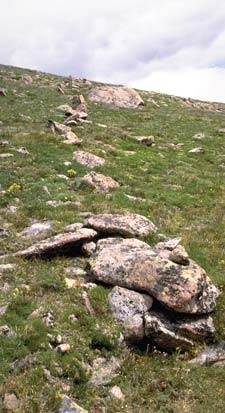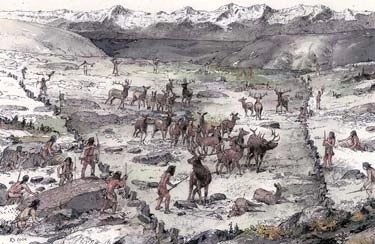Last updated: November 8, 2022
Article
Prehistoric Human Migration

The Question: What were prehistoric human migratory patterns within the park?
Rocky Mountain National Park has been occupied by humans since about 11,000 years ago. Prior to recent archeological surveys researchers knew little about early human migration patterns within the park. Knowledge about the seasonal use of the park can lead to a better understanding of how early humans adapted to life in the mountains.The Project: Perform a comprehensive survey of prehistoric archeological sites.
Through the National Park Service’s Systemwide Archeological Inventory Program (SAIP), Robert Brunswig (University of Northern Colorado) in conjunction with the park’s archeologist William Butler, systematically surveyed Rocky Mountain National Park for archeological sites. The surveys started in areas with high visitor use where archeological sites are most likely to be destroyed, followed by areas along roads with moderate impact, and remote areas that were least likely to be damaged by visitors. Within these general areas, archeologists surveyed specifi c sections based on the likelihood of fi nding a site. Surveying focused on places where people were more likely to live and work, such as meadows, and avoided thick forests and steep slopes. Groups of surveyors walked in rows across the sites and surveyed, recorded, and photographed the evidence and remains that they found.The Results: Early hunter-gatherer bands moved between camps at varying elevations based on seasons and availability of game and wild plant species.
During the five years of surveys, researchers documented over 1,000 sites or isolated finds. Of these, over a third of these resources were from prehistoric and early historic periods. Researchers accurately dated 106 prehistoric or early historic resources using modern methods. Researchers analyzed these artifacts and used them to reconstruct early human migration.Prehistoric humans developed a subsistence pattern based on elevation and seasons. Annual rounds likely involved three stages: (1) late spring to mid summer; (2) mid summer to late summer/mid fall; and (3) late fall to early spring. During stage one, people occupied low elevation mountain base camps while higher elevations were still largely under snow cover. Bands usually moved base camps during stage two to high elevation hunting territories utilizing well established trail systems. Bands followed seasonal migration of elk and bighorn sheep as well as bison and deer. Hunters returned to the same hunting territories each year, and evidence shows that some areas were in periodic use for several millennia. Some of these areas include Mount Ida Ridge, Flattop Mountain, and Bighorn Flats. These areas, often containing game drives, were well suited for hunting and contained confi ning terrain such as narrow areas on steep slopes. People enhanced game drives by constructing ambush blinds and rock wall-lined drive corridors.
Stage three, the wintering stage, was usually spent outside of the park in low mountain valleys. Despite intensive surveys of the park, archeologists did not fi nd any evidence of early people wintering in the park. Evidence shows that hunter-gatherer bands usually moved to Middle Park and North Park directly west and northwest of the park. Over-wintering game herds of bison, elk, deer, and pronghorn as well as plenty of fuel and shelter made these areas ideal places for early humans to spend the winter. It is possible that some bands also spent the winter in Estes Valley. Overall early humans followed the game, allowing them to subsist in the harsh mountain climate of the park.
This summary is based on published, peer-reviewed and/or unpublished reports available at the time of writing. It is not intended as a statement of park policy or as a defi nitive account of research results. For more information on the park’s research program, see www.nps.gov/romo
Written by: Meg Reamer Date: July 2006 Updated: January 2008 Photo credit: NPS-RMNP

